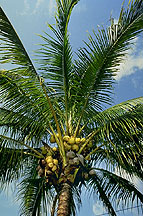
Soy protein, isoflavones, and cardiovascular health: an American Heart Association Science Advisory for professionals from the Nutrition Committee.Soy protein and isoflavones (phytoestrogens) have gained considerable attention for their potential role in improving risk factors for cardiovascular disease. This scientific advisory assesses the more recent work published on soy protein and its component isoflavones.
In the majority of 22 randomized trials, isolated soy protein with isoflavones, as compared with milk or other proteins, decreased LDL cholesterol concentrations; the average effect was approximately 3%. This reduction is very small relative to the large amount of soy protein tested in these studies, averaging 50 g, about half the usual total daily protein intake. No significant effects on HDL cholesterol, triglycerides, lipoprotein(a), or blood pressure were evident. Among 19 studies of soy isoflavones, the average effect on LDL cholesterol and other lipid risk factors was nil. Soy protein and isoflavones have not been shown to lessen vasomotor symptoms of menopause, and results are mixed with regard to soy's ability to slow postmenopausal bone loss. The efficacy and safety of soy isoflavones for preventing or treating cancer of the breast, endometrium, and prostate are not established; evidence from clinical trials is meager and cautionary with regard to a possible adverse effect. For this reason, use of isoflavone supplements in food or pills is not recommended. Thus, earlier research indicating that soy protein has clinically important favorable effects as compared with other proteins has not been confirmed.
In contrast, many soy products should be beneficial to cardiovascular and overall health because of their high content of polyunsaturated fats, fiber, vitamins, and minerals and low content of saturated fat.
Soy May Reduce the Risk of Colorectal CancerA new study published in the American Journal of Clinical Nutrition explores how soyfood consumption may lower the risk of colorectal cancer, or cancer of the colon or rectum, in postmenopausal women. According to the National Cancer Institute, an estimated 71,560 American women were diagnosed with the fourth most common cancer in 2008.
Vanderbilt University School of Medicine researchers found that women who consumed at least 10 grams of soy protein daily were one-third less likely to develop colorectal cancer in comparison to women who consumed little soy. This is the amount of soy protein available in approximately one serving of tofu (1/2 cup), roasted soy nuts (1/4 cup), edamame (1/2 cup) or soy breakfast patties (2 patties).
The study observed soy intake in 68,412 women between the ages of 40 and 70, all free of cancer and diabetes prior to the initial screening. Researchers identified 321 colorectal cancer cases after participants were monitored for an average of 6.4 years. After adjusting for confounding factors, total soyfood intake was inversely associated with colorectal cancer risk among postmenopausal women.
“Research this comprehensive demonstrates how important it is for baby boomer and older women to add soy into their daily diet,” said Lisa Kelly, RD, MPH, for the United Soybean Board. “Furthermore, the study’s recommended serving is a simple and affordable nutritional step towards everyday wellness.”
Evidence shows soy can play an important role in a healthy diet for a variety of reasons. It is a source of high-quality protein, and contains relatively little saturated fat as well as zero grams of trans fat. Soy protein also directly lowers blood cholesterol levels. And, for postmenopausal women in particular, the largest and longest trial published to date reported that the phytoestrogens in soy reduced hot flashes by 50 percent. A range of products – from soymilk to soy burgers to soy protein bars – can help deliver soy’s benefits with convenience.
Soy Nuts May Improve Blood PressureSubstituting soy nuts for other protein sources in a healthy diet appears to lower blood pressure in postmenopausal women, and also may reduce cholesterol levels in women with high blood pressure, according to a report in the May 28 issue of Archives of Internal Medicine, one of the JAMA/Archives journals.
The American Heart Association estimates that high blood pressure (hypertension) affects approximately 50 million Americans and 1 billion individuals worldwide. The most common-and deadly-result is coronary heart disease, according to background information in the article. Women with high blood pressure have four times the risk of heart disease as women with normal blood pressure.
Francine K. Welty, M.D., Ph.D., and colleagues at Beth Israel Deaconess Medical Center, Boston, assigned 60 healthy post-menopausal women to eat two diets for eight weeks each in random order. The first diet, the Therapeutic Lifestyle Changes (TLC) diet, consisted of 30 percent of calories from fat (with 7 percent or less from saturated fat), 15 percent from protein and 55 percent from carbohydrates; 1,200 milligrams of calcium per day; two meals of fatty fish (such as salmon or tuna) per week; and less than 200 milligrams of cholesterol per day. The other diet had the same calorie, fat and protein content, but the women were instructed to replace 25 grams of protein with one-half cup of unsalted soy nuts. Blood pressure and blood samples for cholesterol testing were taken at the beginning and end of each eight-week period.
At the beginning of the study, 12 women had high blood pressure (140/90 milligrams of mercury or higher) and 48 had normal blood pressure. "Soy nut supplementation significantly reduced systolic [top number] and diastolic [bottom number] blood pressure in all 12 hypertensive women and in 40 of the 48 normotensive women," the authors write. "Compared with the TLC diet alone, the TLC diet plus soy nuts lowered systolic and diastolic blood pressure 9.9 percent and 6.8 percent, respectively, in hypertensive women and 5.2 percent and 2.9 percent, respectively, in normotensive women."
In women with high blood pressure, the soy diet also decreased levels of low-density lipoprotein ("bad") cholesterol by an average of 11 percent and levels of apoliprotein B (a particle that carries bad cholesterol) by an average of 8 percent. Cholesterol levels remained the same in women with normal blood pressure.
"A 12-millimeter of mercury decrease in systolic blood pressure for 10 years has been estimated to prevent one death for every 11 patients with stage one hypertension treated; therefore, the average reduction of 15 milligrams of mercury in systolic blood pressure in hypertensive women in the present study could have significant implications for reducing cardiovascular risk and death on a population basis," the authors write.__"This study was performed in the free-living state; therefore, dietary soy may be a practical, safe and inexpensive modality to reduce blood pressure. If the findings are repeated in a larger group they may have important implications for reducing cardiovascular risk in postmenopausal women on a population basis," they conclude.
Eating soy early in life may reduce breast cancer among Asian womenAsian-American women who ate higher amounts of soy during childhood had a 58 percent reduced risk of breast cancer, according to a study published in Cancer Epidemiology, Biomarkers and Prevention, a journal of the American Association for Cancer Research.
"Historically, breast cancer incidence rates have been four to seven times higher among white women in the U.S. than in women in China or Japan. However, when Asian women migrate to the U.S., their breast cancer risk rises over several generations and reaches that of U.S. white women, suggesting that modifiable factors, rather than genetics, are responsible for the international differences. These lifestyle or environmental factors remain elusive; our study was designed to identify them," said Regina Ziegler, Ph.D., M.P.H., a senior investigator in the NCI Division of Cancer Epidemiology and Genetics (DCEG).
The current study focused on women of Chinese, Japanese and Filipino descent who were living in San Francisco, Oakland, Los Angeles or Hawaii. Researchers interviewed 597 women with breast cancer and 966 healthy women. If the women had mothers living in the United States, researchers interviewed those mothers to determine the frequency of soy consumption in childhood.
Researchers divided soy intake into thirds and compared the highest and lowest groups. High intake of soy in childhood was associated with a 58 percent reduction in breast cancer. A high level of soy intake in the adolescent and adult years was associated with a 20 to 25 percent reduction. The childhood relationship held in all three races and all three study sites, and in women with and without a family history of breast cancer. "Since the effects of childhood soy intake could not be explained by measures other than Asian lifestyle during childhood or adult life, early soy intake might itself be protective," said the study's lead investigator, Larissa Korde, M.D., M.P.H., a staff clinician at the NCI's Clinical Genetics Branch.
"Childhood soy intake was significantly associated with reduced breast cancer risk in our study, suggesting that the timing of soy intake may be especially critical," said Korde. The underlying mechanism is not known. Korde said her study suggests that early soy intake may have a biological role in breast cancer prevention. "Soy isoflavones have estrogenic properties that may cause changes in breast tissue. Animal models suggest that ingestion of soy may result in earlier maturation of breast tissue and increased resistance to carcinogens."
As provocative as the findings are, Ziegler cautioned that it would be premature to recommend changes in childhood diet. "This is the first study to evaluate childhood soy intake and subsequent breast cancer risk, and this one result is not enough for a public health recommendation," she said. "The findings need to be replicated through additional research."
Soybean component reduces menopause effectsSoy aglycons of isoflavone (SAI), a group of soybean constituent chemicals, have been shown to promote health in a rat model of the menopause. The research, described in BioMed Central's open access journal Nutrition & Metabolism, shows how dietary supplementation with SAI lowers cholesterol, increases the anti-oxidative properties of the liver and prevents degeneration of the vaginal lining.
Robin Chiou led a team of researchers from National Chiayi University, Taiwan, who studied the effects of the dietary supplement on a group of female rats that had undergone ovary removal. He said, "These ovariectomized animals are a good model for study of the menopause as the loss of oestrogen from the ovaries mimics the natural reduction in oestrogen seen in menopausal women. SAI itself has weak oestrogenic properties and we've shown here that menopause-related syndromes can be prevented or improved by dietary supplementation with the compounds it contains".
In comparison to control animals, the authors found that the ovariectomized rats fed a diet enriched with SAI showed increased liver antioxidative activities and improved lipid profiles. Levels of harmful LDL cholesterol were reduced, while beneficial HDL cholesterol was increased. According to Chiou, "It is generally agreed that the higher HDL and the lower LDL concentrations are of benefit in chemoprevention of cardiovascular diseases. Our findings support the indication that soybean consumption may prevent coronary heart disease".
The authors hope that dietary soy supplementation may provide an alternative to hormone replacement therapy (HRT), which has been linked to the development of uterus and breast cancers.









